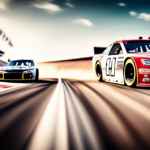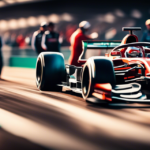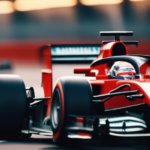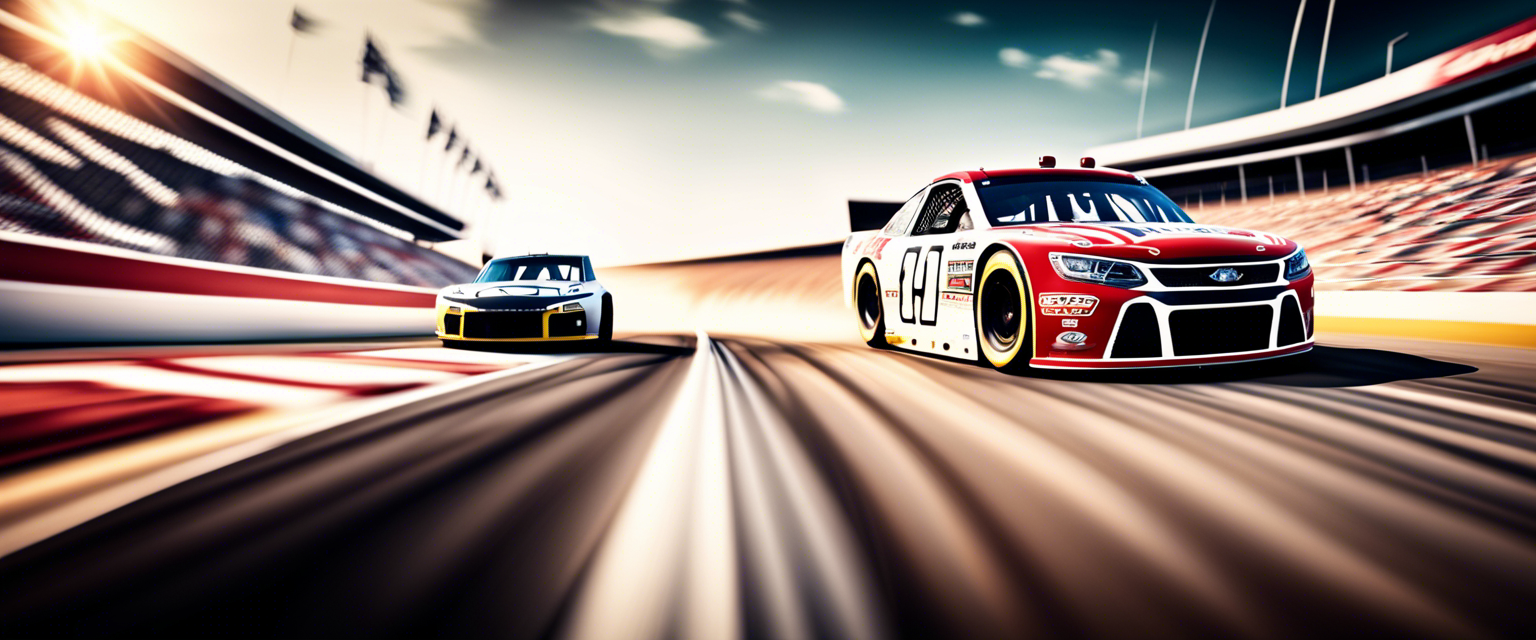NASCAR: Tracks and Features
Get ready for a heart-pounding exploration of the tracks and features that make this high-speed sport an adrenaline-fueled spectacle like no other.
Hey there, racing enthusiasts and thrill seekers! I’m Grant, your go-to guy when it comes to everything that makes your heart race faster than a stock car at full throttle. Today, I’m here to share my extensive knowledge about NASCAR tracks and features that play a crucial role in this heart-stopping sport.
While understanding the tracks is important, it’s equally crucial to analyze each driver’s performance on particular tracks.
For those of you unfamiliar with NASCAR, let me give you the lowdown. NASCAR, short for the National Association for Stock Car Auto Racing, is the pinnacle of American motorsport. With its origin dating back to the moonshine-filled days of Prohibition, this fast-paced phenomenon has evolved into a high-stakes competition that brings fans from all walks of life together.
Now, you may think that NASCAR is simply about cars zooming around ovals, but it’s so much more than that. Each track has its own unique characteristics and features that pose different challenges to drivers, making every race a thrilling, edge-of-your-seat experience.
Throughout this essay series, I’ll dive into the various aspects of NASCAR tracks and features, providing you with insider insights that will leave you ready to place your bets and cheer on your favorite drivers. From the banked turns that defy logic to the incredible pit stops that can change the course of a race, we’ll cover it all.
So, grab your lucky cap, buckle your seatbelt, and join me as we explore the tracks and features that make NASCAR the epitome of speed, skill, and excitement. Let’s hit the gas and embark on a journey that’ll leave you hungry for more racing action!
Types of NASCAR Tracks:
Oval Tracks:
First up, we have the classic oval tracks. These babies are like the bread and butter of NASCAR. They come in different sizes and shapes, ranging from short tracks like Bristol Motor Speedway, where drivers have to maneuver tight turns, to long tracks like Daytona International Speedway, where they can hit insane speeds.
Now, here’s a little tip: when it comes to betting on oval tracks, it’s all about knowing which drivers excel on these types of courses. Some drivers have a knack for dominating short tracks, while others thrive on the superspeedways. Keep an eye on their past performances and trends, and you might just hit the jackpot.
Road Courses:
Alright, enough of going in circles, let’s talk about the road courses. These tracks are like the rebellious cousins of NASCAR. Instead of turning left all the damn time, drivers have to navigate both left and right as they tackle twists, turns, and elevation changes.
You might be thinking, “Grant, what does this mean for my bets?” Well, road courses are a whole different ball game. It requires a mix of skill, strategy, and a touch of luck. Some drivers naturally excel on road courses, while others struggle to keep up. Keep an eye on the “road course ringers” – those drivers who aren’t regulars in NASCAR but somehow become road course maestros. Trust me, they can shake things up and bring a surprise victory.
Superspeedways:
And now, my fellow speed demons, we have the superspeedways. These tracks are where the real high-speed action goes down, and where you can witness cars flying by at mind-boggling speeds. Tracks like Talladega Superspeedway and Daytona International Speedway are the legendary arenas for drivers to showcase their need for speed.
When it comes to superspeedway betting, things can get a bit unpredictable. Due to the high speeds and the draft, a small error or a sudden gust of wind can cause havoc in the blink of an eye. So, my advice would be to keep an eye on the drivers who have proven themselves in these restrictor plate races. They know how to ride the edge, and those are the ones you want to bet on.
Track Characteristics and Impact on Racing
Now that we’ve covered the different types of NASCAR tracks, it’s time to dive into the unique characteristics of each track and how they impact racing. Buckle up, folks, because this is where the rubber meets the road!
Oval Tracks: As mentioned earlier, oval tracks are the bread and butter of NASCAR. These tracks may all look similar at first glance, but don’t be fooled – each one has its own quirks and challenges. Whether it’s the high banks of Daytona, the tight turns of Bristol, or the long straights of Indianapolis, each oval track tests the skills of both drivers and bettors alike.
Banked Turns: One crucial aspect of oval tracks is the degree of banking in the turns. Higher banking allows cars to carry more speed through the turns, resulting in faster lap times and more intense battles for position. Bristol Motor Speedway, for example, boasts some steep banking that’ll make your head spin, both figuratively and literally.
Track Surface: The surface of a track can also have a significant impact on the race. Freshly paved tracks generally offer more grip, allowing drivers to push their cars to the limits. Older, more weathered tracks, on the other hand, can be trickier to navigate, and tire management becomes a crucial factor during the race.
Road Courses: Just when you thought NASCAR was all about oval tracks, enter the thrilling world of road courses! These tracks offer a unique challenge, as drivers must navigate left and right turns, elevation changes, and even a few twists and turns that would put a roller coaster to shame.
Strategy and Skills: Road courses require a different set of skills compared to oval tracks. Drivers need to be adept at shifting gears, braking, and choosing the perfect racing line. And let’s not forget about strategy. Choosing the right time to pit for fuel and tires can make or break a driver’s chances of victory.
A Favorite Among Bettors: Road courses are a favorite among astute bettors. With their unpredictable nature and the potential for surprise winners, these races add an extra layer of excitement to the world of sports betting. Just remember, folks, picking a winner at a road course requires a keen eye, a bit of luck, and a touch of that Grant magic!
Superspeedways: Last but not least, we have the kings of speed – superspeedways. These massive tracks, such as Daytona and Talladega, are where the cars stretch their legs and reach mind-boggling speeds.
Drafting: At superspeedways, drafting becomes a crucial strategy for drivers. By tucking their car in behind another, they can cut through the air more efficiently, gaining speed and conserving fuel. This creates breathtaking pack racing and intense battles for position, leaving bettors on the edge of their seats.
Tame the Beast: However, with high speeds come high risks. The margin for error is minimal, and the famous “Big One” – a massive multi-car wreck – is always a looming threat. Bettors must gauge each driver’s ability to avoid trouble and make strategic moves in the ever-changing dynamics of superspeedway racing.
Notable NASCAR Tracks
Alright, folks, we’ve covered the types of NASCAR tracks and their characteristics. Now, let’s dive into some of the most iconic and noteworthy tracks in the world of NASCAR racing. These tracks have seen countless battles, nail-biting finishes, and legendary moments that have etched themselves in racing history. So, fasten your seatbelts, because here we go!
1. Daytona International Speedway – Ah, Daytona. The birthplace of NASCAR’s most prestigious event, the Daytona 500. This iconic superspeedway in Florida has a long and storied history. With its high-banked turns and long straightaways, it’s a true test of speed and skill. And let me tell you, folks, when it comes to betting on Daytona, anything can happen. You’ve got to keep your eyes on those restrictor plates and the drafting tactics. It’s all about positioning, strategy, and a little bit of luck.
2. Talladega Superspeedway – If you thought Daytona was intense, just wait till you experience Talladega. This Alabama track is known as the “Biggest and Baddest” for a reason. With its incredibly steep banking and lightning-fast speeds, it’s a recipe for some heart-stopping action. The best part? The close, wheel-to-wheel racing that often results in photo-finishes. But remember, folks, at Talladega, the unexpected is the norm. So, buckle up, keep an eye on those restrictor plates, and be prepared for some wild betting rides.
3. Bristol Motor Speedway – Welcome to the “Thunderdome” of NASCAR racing. Bristol is a unique beast. Dubbed as the “World’s Fastest Half-Mile,” this Tennessee short track is all about high-banked turns and bumper-to-bumper action. When the green flag drops at Bristol, sparks fly, tempers flare, and cars bump and grind like there’s no tomorrow. It’s a short-track mayhem that demands precision and nerves of steel. If you’re into betting on Bristol, pay attention to those aggressive drivers who know how to navigate through the chaos withouting their chances. Trust me, there’s nothing like a good old short-track under the Friday night lights.
4. Martinsville Speedway – Don’t let the fact that Martinsville is a short track fool you. This Virginia gem may be just a mile in length, but it packs a punch. Dubbed as the “clip” due to its peculiar shape, Martinsville is all about tight turns, straightaways, and a little bit of old-school NASCAR history. It’s the track on the NASCAR circuit, but it’s also one of the toughest. Patience, tire management, and strategic pit stops are key at Martinsville. When it comes to betting on this track, watch out for those drivers who excel at short-track fines and tire preservation.
5. Indianapolis Motor Speedway – We can’t talk about notable NASCAR tracks without mentioning the legendary Indianapolis Motor Speedway. Yes, you may know it more for the Indianapolis 500, but NASCAR made its way there too. It’s a historic track with a rich heritage and a prestigious event known as the Brick 400 This iconic oval track boasts long straightaways and flat turns, making it a different challenge compared to the high-banked superspeedways Fuel mileage, tire wear, and pit strategy often come into play at Indianapolis. So, when you’re betting on the Brickyard, keep an eye on those teams that can adapt and make the right calls to secure the win.
Betting Strategies for Different Tracks
Now that we know about the different types of tracks and their unique characteristics, it’s time to talk about the juicy stuff – betting strategies! Remember, winning at sports betting is not all about luck; it’s about strategy, analysis, and making informed decisions. So, let me share some insider tips on how to boost your chances of making the right bets on different NASCAR tracks.
The Short Tracks Dash – When it comes to short tracks like Bristol Motor Speedway or Martinsville Speedway, it’s all about speed, skill, and survival. These tracks are known for their tight turns and narrow lanes that demand precise driving. Look out for drivers who excel in close-quarter battles and have a solid track record on these types of circuits. Remember, a little aggression can go a long way!
Intermediate Tracks Showdown – Ah, the intermediate tracks – the bread and butter of the NASCAR schedule. Tracks like Charlotte Motor Speedway and Texas Motor Speedway fall into this category. Here, you want to look for drivers who can maintain a consistent pace while navigating varying banking angles. Keep an eye on those who can adapt to different track conditions and have a knack for finding the racing groove.
Superspeedway Spectacle – Now, brace yourselves for the superspeedways like Daytona International Speedway and Talladega Superspeedway. These tracks are all about raw speed and the thrilling art of drafting. It’s like a high-speed chess match where drivers jockey for position, forming alliances for that crucial advantage. Look for skilled drivers who are adept at the art of drafting and have a fearless mentality to survive the chaos that can erupt at any moment.
Road Course Roulette – Last but not least, we have the road courses, like Sonoma Raceway and Watkins Glen International. These tracks throw a curveball at the traditional oval racing, featuring twists, turns, and elevation changes. Here, precision and expertise in handling both left and right turns are paramount. Look for drivers with a solid track record in road racing and a special talent for navigating these tricky, non-oval circuits.
While understanding the tracks is important, it’s equally crucial to analyze each driver’s performance on particular tracks. Look for patterns, study their historical records on specific tracks, and keep an eye on their recent form. And of course, never underestimate the power of gut instinct – sometimes, picking a winner comes down to a gut feeling supported by a mound of research.
Alright, my fellow sports betting enthusiasts, armed with this knowledge about NASCAR tracks and betting strategies, you’re ready to conquer the world of NASCAR betting. Remember to gamble responsibly, have fun, and always trust your gut. Until next time, keep those engines revving and those bets winning!
Remember, stay tuned for more exhilarating insights from your favorite sports betting connoisseur,
Grant
- Learn Advanced Bankroll Management
 Sports betting can be unpredictable, just like life. You never know when a favorite horse might pull up lame or when the underdog team might pull off a stunning upset.
Sports betting can be unpredictable, just like life. You never know when a favorite horse might pull up lame or when the underdog team might pull off a stunning upset. - NASCAR: Tracks and Features
 You may think that NASCAR is simply about cars zooming around ovals, but it’s so much more than that. Each track has its own unique characteristics and features that pose different challenges to drivers, making every race a thrilling, edge-of-your-seat experience.
You may think that NASCAR is simply about cars zooming around ovals, but it’s so much more than that. Each track has its own unique characteristics and features that pose different challenges to drivers, making every race a thrilling, edge-of-your-seat experience. - Formula 1: The Tracks and Features
 Prepare to dive headfirst into the exhilarating world of Formula 1 racing, where speed, precision, and sheer adrenaline take center stage.
Prepare to dive headfirst into the exhilarating world of Formula 1 racing, where speed, precision, and sheer adrenaline take center stage. - Betting on Formula One Racing: A Beginners Guide
 We’re about to embark on a Formula One journey that will leave you ready to outsmart the odds, make informed decisions, and hopefully, cash in some sweet victories.
We’re about to embark on a Formula One journey that will leave you ready to outsmart the odds, make informed decisions, and hopefully, cash in some sweet victories. - How to Pick the Winner in Formula 1 Racing
 Get ready to uncover the hidden tricks and tips that could turn you into a master of picking the winning drivers. In Formula 1, it’s all about speed, precision, and strategy.
Get ready to uncover the hidden tricks and tips that could turn you into a master of picking the winning drivers. In Formula 1, it’s all about speed, precision, and strategy.
